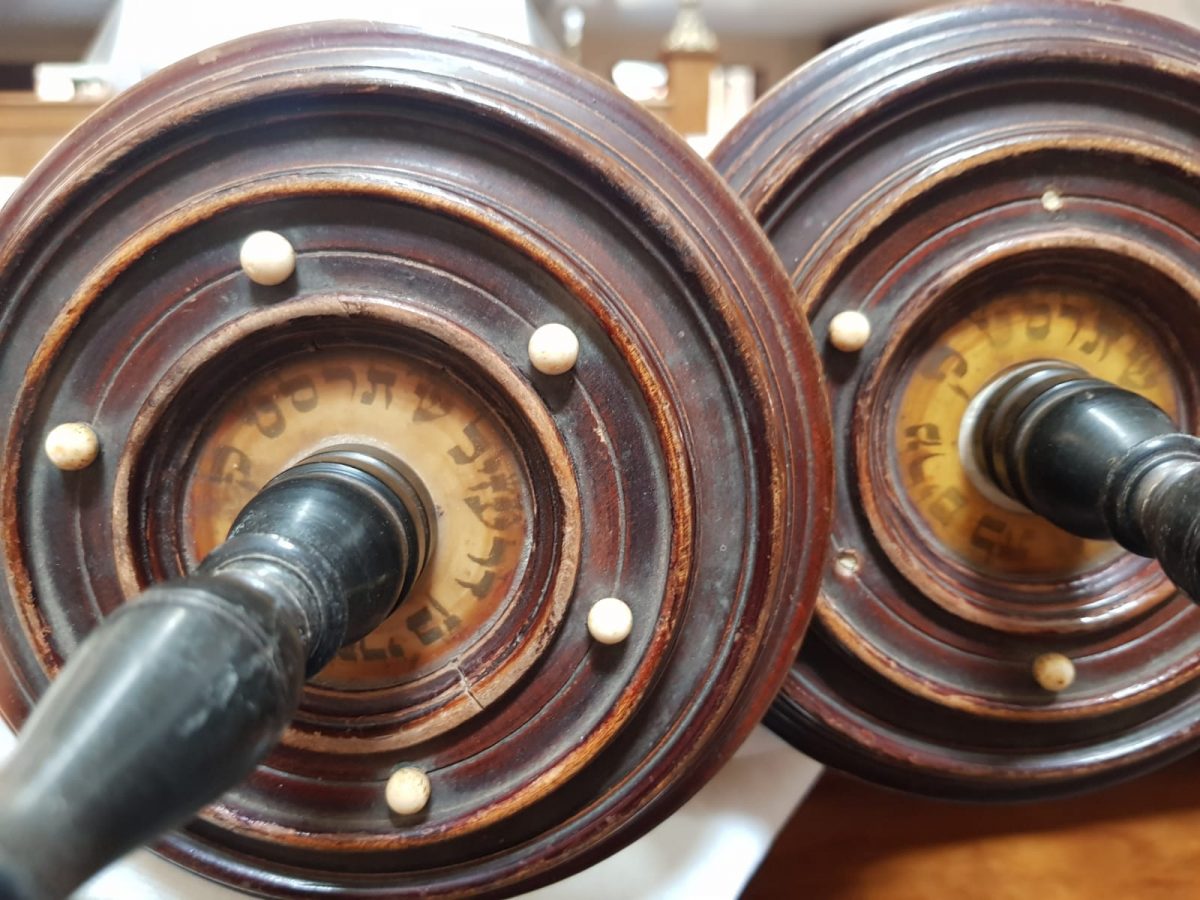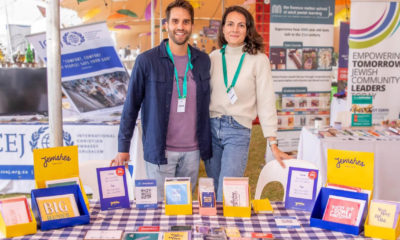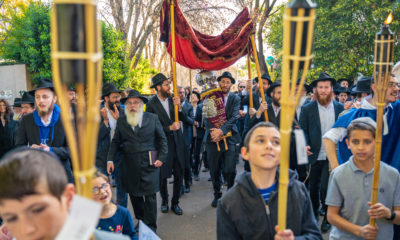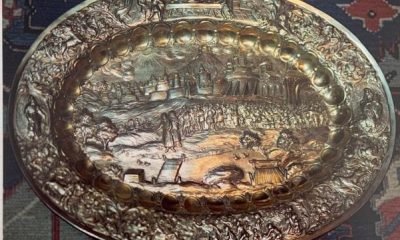
Featured Item

Ancient Torahs in local shuls tell story of Jewish endurance
Published
3 years agoon
By
Jordan MosheWhen Judaica collector David Sussman heard about a century-old Sefer Torah being kept by a non-Jewish Polish man living in Krakow, he knew that it belonged in Jewish hands.
After extremely careful planning, the Torah was smuggled across the Polish border, flown out of Germany, and returned to its rightful place in the Aron Kodesh of Johannesburg’s Chabad of Sandton Shul.
Beyond those written by local South African sofrim (scribes), our community possesses Torah scrolls whose rich and remarkable histories can be traced back to Eastern Europe. These are inextricably intertwined with the lives of Jews who arrived in the country from Poland, Lithuania, and other countries.
Although a number of such Torah scrolls ended up on our shores, many of their vibrant histories remain unknown or have been lost over time. As admired as the ornately carved wooden handles, painstakingly written script, and beautifully designed slipcovers may be, many of them possess stories we may never know.
Thankfully, there are some exceptions. From nail-biting rescues to clandestine concealments in travel suitcases, Torah scrolls have arrived in South Africa with stories which are often beyond comprehension.
For instance, one of the Torah scrolls at Sydenham Shul comes from Krakenowa, Lithuania, and was saved from certain destruction after the local Jewish population was expelled from the region. Commissioned by the family of Cherne Stein in the early 1900s, it was left behind when the family was exiled in 1914. Today, it’s owned by Stanley Seeff, a Sydenham congregant whose father bought the Sefer Torah in 1979.
“It’s really part of the family,” says Seeff. “My late father bought it from Israel Stein, a descendant of Cherne. They were close friends, and my father saw the tremendous value in the history of that Torah.”
According to information passed down, the Torah was saved by Stein when she hired a horse and cart to get her back to Krakenowa from Ponovez, where she and her family were waiting to board a train. Undaunted by the 30-mile (48km) journey, she valiantly rode to her hometown, and returned safely with the Torah wrapped in her shawl. The family kept it throughout their years in Russian exile before it came to South Africa.
Also hailing from Krakenowa is the Torah owned by the family of Tina Kallmeyer, whose great-grandfather, Eli Josselowitz, brought the Torah hidden in his suitcase when he arrived in the country from Lithuania. A carpenter by trade, Josselowitz crafted the handles of the Torah himself, carving his name into the wood together with that of his wife.
“I didn’t really know much about the family Torah until I was an adult,” Kallmeyer says, “It probably arrived here in the late 1880s when my great-grandparents arrived, and was later passed down to my father and then to my brother and nephew. It was initially lodged at Jeppe Shul, then in Emmarentia, and then at Sydenham Shul, before arriving at Pine Street Shul where it stays today.”
“Although we know little about its history, my family has always treasured it. It’s been part of our lives.”
Sussman’s escapade took place in 1999, three years after he and his wife visited Poland for the first time and resolved to save pre-Holocaust Judaica.
“We landed up buying a business in Poland,” Sussman recounts. “The chief executive was a Catholic man, and he used to scout out Judaica for me among locals so that I could get it back into Jewish hands.
“He called me one day and spoke of an 80-year-old Catholic man who had a Torah in perfect condition. I was sceptical that it was really in a good state, but I wanted to get it out of his hands, so I arranged to buy it from him.”
According to the information gleaned, the Torah had been dug up from the ground by the elderly man after he’d witnessed a group of Jews bury it decades before. When they never returned, he exhumed the scroll, and stored it in a cupboard. Sussman instructed his employee to visit the man, ask his price, and pay whatever he demanded. In spite of initial refusals, Sussman persisted.
“I told my guy to go back there and tell them it doesn’t belong to them, pay them, and take it,” he said. “He did just that.”
With the Torah successfully acquired, Sussman arranged for it to be smuggled out of the country using his truck drivers, who hid the Torah under samples, and drove across the border into Germany. It was there that Sussman collected the Torah, and flew with it in his arms to South Africa.
“I arrived on a Sunday morning and called my rabbi and friend, Yossi Hecht, of Chabad of Sandton to tell him that the Torah had arrived,” Sussman recounts. “He arrived with sofer Rabbi Chaim Klein that night.
“We cleared the desk, and opened it up. The look in their eyes is one I’ll never forget. It must have been the same look Abraham had when he was told Sarah would have a baby. They were absolutely enthralled.”
To their amazement, the Torah was, indeed, in perfect condition. Written half in Polish on Polish parchment and half in Russian on Russian parchment, the scroll was scribed in 1908, making it almost a century old at the time. Today 112 years old, the Torah is a fundamental part of the community at Chabad of Sandton.
The story of a Torah in the ark at Victory Park Shul can be traced back to the village of Punia, Lithuania. Known as the Gamsu family Torah, according to family legend, it arrived in South Africa in the late 1800s wrapped in a tallit and conveyed on a cart drawn by a donkey to the town of Nigel with Nachum (Nathan) Gamsu.
“Nathan became the mayor of Nigel after he and his family arrived on the far East Rand around the time of the Boer War,” says Beverley Lutrin, Gamsu’s granddaughter. “They brought a Torah with them, keeping it in their home and running services for the small Jewish community in a dedicated room.”
The Torah was later moved to a shul built in the area before being moved to the Victory Park Shul years later when the community dwindled. Although used by the shul, it remains the property of Lutrin’s family.
Along with those at Sydenham, Chabad of Sandton, and Pine Street, this Sefer Torah remains in use by the community, proof of Jewish mettle.
“The Torah speaks to the survival and endurance of the Jews under the direst circumstances,” Sussman says. “The Torah of the Jewish people has not only survived but thrived. No matter how much they’ve tried to destroy us, they haven’t got it right. A Torah will always endure.”











Antoinette
May 9, 2021 at 3:42 pm
Could David Sussman please contact me urgently. I have some old Jewish religious books dating back to 1864.